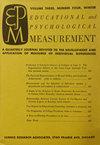Evaluating The Predictive Reliability of Neural Networks in Psychological Research With Random Datasets
IF 2.3
3区 心理学
Q2 MATHEMATICS, INTERDISCIPLINARY APPLICATIONS
引用次数: 0
Abstract
Psychologists are emphasizing the importance of predictive conclusions. Machine learning methods, such as supervised neural networks, have been used in psychological studies as they naturally fit prediction tasks. However, we are concerned about whether neural networks fitted with random datasets (i.e., datasets where there is no relationship between ordinal independent variables and continuous or binary-dependent variables) can provide an acceptable level of predictive performance from a psychologist’s perspective. Through a Monte Carlo simulation study, we found that this kind of erroneous conclusion is not likely to be drawn as long as the sample size is larger than 50 with continuous-dependent variables. However, when the dependent variable is binary, the minimum sample size is 500 when the criteria are balanced accuracy ≥ .6 or balanced accuracy ≥ .65, and the minimum sample size is 200 when the criterion is balanced accuracy ≥ .7 for a decision error less than .05. In the case where area under the curve (AUC) is used as a metric, a sample size of 100, 200, and 500 is necessary when the minimum acceptable performance level is set at AUC ≥ .7, AUC ≥ .65, and AUC ≥ .6, respectively. The results found by this study can be used for sample size planning for psychologists who wish to apply neural networks for a qualitatively reliable conclusion. Further directions and limitations of the study are also discussed.利用随机数据集评估神经网络在心理学研究中的预测可靠性
心理学家正在强调预测结论的重要性。机器学习方法(如有监督的神经网络)已被用于心理学研究,因为它们很自然地适合预测任务。然而,我们担心的是,从心理学家的角度来看,使用随机数据集(即序数自变量与连续或二元依赖变量之间不存在关系的数据集)拟合的神经网络能否提供可接受水平的预测性能。通过蒙特卡罗模拟研究,我们发现只要样本量大于 50 个连续因变量,就不太可能得出这种错误的结论。然而,当因变量为二元变量时,当标准为均衡准确度≥.6 或均衡准确度≥.65 时,最小样本量为 500 个;当标准为均衡准确度≥.7 时,最小样本量为 200 个,决策误差小于 0.05。在使用曲线下面积(AUC)作为指标的情况下,当最低可接受性能水平设定为 AUC ≥ .7、AUC ≥ .65 和 AUC ≥ .6 时,分别需要 100、200 和 500 个样本量。对于希望应用神经网络得出定性可靠结论的心理学家来说,本研究发现的结果可用于样本量规划。本研究的进一步方向和局限性也在讨论之列。
本文章由计算机程序翻译,如有差异,请以英文原文为准。
求助全文
约1分钟内获得全文
求助全文
来源期刊

Educational and Psychological Measurement
医学-数学跨学科应用
CiteScore
5.50
自引率
7.40%
发文量
49
审稿时长
6-12 weeks
期刊介绍:
Educational and Psychological Measurement (EPM) publishes referred scholarly work from all academic disciplines interested in the study of measurement theory, problems, and issues. Theoretical articles address new developments and techniques, and applied articles deal with innovation applications.
 求助内容:
求助内容: 应助结果提醒方式:
应助结果提醒方式:


